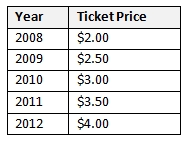Personal Finance Big Ideas taught in this task:
TASK
Every year a carnival comes to Hallie’s town. The price of tickets to ride the rides has gone up every year.

- In 2008, Hallie’s allowance was $9.00 a month. How many carnival tickets could she buy with one month’s allowance?
- How many carnival tickets could she buy in 2012 with $9.00?
- In 2012, Hallie’s allowance was $14.00 per month. How much more did a carnival ticket cost in 2008 than it did in 2012? How much more allowance was she receiving per month?
- Was Hallie able to buy more carnival tickets in 2008 or in 2012 with one month’s allowance?
- What would Hallie’s allowance need to be in 2012 in order for her to be able to buy as many carnival tickets as she could in 2008?
- What happens to your ability to buy things if prices increase and your allowance doesn’t increase?
COMMENTARY
The purpose of this task is for students to solve multi-step problems in a context involving a concept that supports financial literacy, namely inflation. Inflation is a sustained increase in the average price level. In this task, students can see that if the price level increases and people’s incomes do not increase, they aren’t able to purchase as many goods and services; in other words, their purchasing power decreases. If the price level rises and people’s incomes increase at a slower rate, their purchasing power increases but not as much as if their income increases at the same rate as the cost of goods and services. This task is a variation on another task 6.NS Movie Tickets that also addresses inflation.
From a mathematical perspective, students are asked to solve word problems involving operations only with whole numbers because students are not required in fourth grade to compute with decimal numbers. However, they are asked to understand decimal notation for fractions with denominators of 10 and 100 (see 4.NF.6) and so this task capitalizes on this by representing whole numbers with decimal notation and including dollar amounts that are not whole numbers in the table. Also, students in 4th grade should be comfortable with two-column tables (see e.g. 4.MD.1), so this task gives them some practice reading information in a table. Note that the numbers were chosen specifically so that there would be remainders for them to interpret (as described in 4.OA.3).
This task is part of a set collaboratively developed by Money as You Learn, an initiative inspired by recommendations of the President’s Advisory Council on Financial Capability, and Illustrative Mathematics. Integrating essential financial literacy concepts into the teaching of the Common Core State Standards can strengthen teaching of the Common Core and expose students to knowledge and skills they need to become financially capable young adults. A mapping of essential personal finance concepts and skills against the Common Core State Standards as well as additional tasks and texts will be available at www.moneyasyoulearn.org. This task and additional personal finance-related mathematics tasks are available at www.illustrativemathematics.org and are tagged “financial literacy.”
SOLUTION
- If she has $9 and tickets cost $2 each, we divide 9 by 2 to find out how many tickets she has (this is a “How many groups?” division problem).
9÷2=4, with a remainder of 1
- So she could buy 4 carnival tickets with one month’s allowance in 2008 and would have $1.00 left over.
- As before, we divide to find how many tickets she can buy. 9 ÷ 4 = 2 with a remainder of 1. So if her allowance was $9.00 in 2012, she could only buy 2 tickets with one month’s allowance.
- Since tickets cost $4 in 2012 and they cost $2.00 in 2008, and
4−2=2a carnival ticket cost $2.00 more in 2012 than it did in 2008. Her allowance was $9.00 and now it is $14.00, and
14−9=5
so her allowance increased by $5.00.
- We will divide as we did in parts (a) and (b)
14÷4=3, with a remainder of 2So she could buy 3 carnival tickets with one month’s allowance in 2012 and would have $2.00 left over. Even though her allowance went up, the number of tickets she could buy went down.
- Since carnival tickets cost $4.00 in 2012 and she could buy 4 tickets in 2008, and 4 × 4 = 16, her allowance in 2012 would need to be at least $16.
- You can buy fewer things if prices increase but your allowance doesn’t increase.

